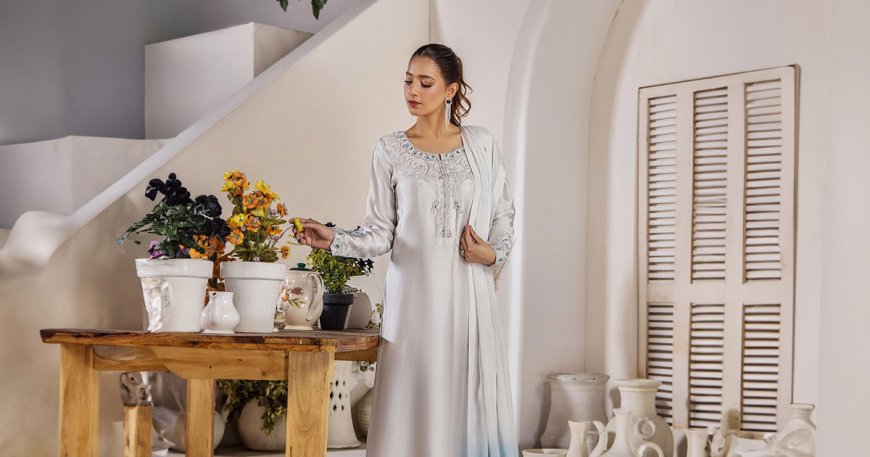Pakistani fashion: An Active Tapestry of Modernism and Tradition

Reflecting the rich cultural legacy of Pakistan and its modern ambitions, Pakistani fashion is a lively and energetic sector Pakistan's fashion landscape is a distinctive mix of modern trends and traditional features that produces a look that appeals locally as well as abroad. Examining Pakistani fashion's historical roots, contemporary development, and the influence of designers, this discussion explores its many elements.
Pakistani Fashion's Historical Roots
Pakistani fashion has origins firmly ingrained in the varied cultural and historical tapestry of the nation. Typical of the country's legacy are traditional clothing include the Shalwar Kameez, Sari, and Sherwani. These clothes are more than just clothes; they are a tribute to centuries-old customs carried down through the years.
Rich fabrics, complex embroidery, and painstaking handwork define traditional Pakistani dress. Traditionally Pakistani clothing is made with techniques including Chikankari, Phulkari, and Zardozi embroidery. Often done by hand and reflecting the painstaking attention to detail defining Pakistani fashion, these techniques call for talented artists and craftspeople.
Evolution and Today’s trend
Pakistani fashion has changed throughout time, adding modern components while yet maintaining its traditional core. Eastern and Western inspirations combined in modern Pakistani fashion produce a distinctive and varied style. Designers are experimenting with cuts, colors, and textiles more and more to produce fresh ideas appealing to a worldwide market.
In metropolitan regions, where younger people commonly combine traditional and modern attire, Western fashion is especially visible. This mixing reflects the larger cultural changes and globalization rather than only a trend. Western fashions have been adapted to produce fusion dress, which mixes aspects of both traditions and is therefore flexible and appealing to a large audience.
The impact of Fashion week
Fashion weeks in Islamabad, Karachi, and Lahore have been increasingly important for presenting Pakistani designers' originality and inventiveness. These gatherings give designers a stage on which to showcase their creations to a wider audience including fashionistas and foreign consumers. Fashion weeks have been instrumental in bringing Pakistani fashion on the international scene and stressing its potential and talent.
Using these venues, designers have become well-known for their creations that combine modern designs with traditional workmanship. Her creations are evidence of the adaptability and richness of Pakistani fashion, showing how classic components may be modernized.
Renewable Pakistani Fashion
The worldwide fashion business now gives sustainability a lot of attention; Pakistani is not an exception. These days, a lot of Pakistani designers support ethical manufacturing techniques and use environmentally friendly materials. Growing knowledge of environmental problems and a need for ethical fashion are driving this change toward sustainability.
Organic materials, natural dyes, and traditional handcrafted methods define sustainable fashion in Pakistani. Designers are also emphasizing on producing timeless works that go beyond seasonal trends to support a more environmentally friendly attitude of fashion consumption. Apart from benefiting the surroundings, this dedication to sustainability helps regional artists and preserves age-old crafts.
Crossing Modernity and Tradition
Renowned in Pakistani fashion, Shireen Lakdawala has made major contributions to the field by combining modern aesthetics with traditional aspects. Her designs that appeal to a discriminating audience, rich fabrics, and minute craftsmanship are well-known.
Offering a great mix of history and creativity has epitomized Pakistani fashion. Designs recreated in modern forms frequently feature classic needlework methods and motifs. This strategy not only protects Pakistani's rich legacy of fashion but also makes it relevant for customers of today who are fashion forward.
Shireen Lakdawala's designs are evidence of the industry's potential and inventiveness for those wishing to really enjoy the core of Pakistani design. Her creations mirror the larger trends in Pakistani fashion, in which modernism and legacy live peacefully.
Global Appeal of Pakistani Fashion
Pakistani designers' inventiveness and ingenuity are driving increasing global appeal for their work. Now frequent attendees in international fashion shows, Pakistani fashion businesses are praised for their ability to combine modern and traditional inspirations. Fashionistas all around love Pakistani fashion because of its vivid colors, detailed workmanship, and original patterns.
Fashion stars and celebrities have been seen sporting Pakistani designs, hence enhancing the industry's visibility on international scene. For Pakistani designers, this global awareness has opened new markets and presented chances for cooperation and growth.
Conclusion
Pakistani fashion is a dynamic and changing sector anchored in history yet always innovating. Combining classic features with contemporary ideas produces a distinctive look that appeals locally as well as abroad. Designers help to close the gap between legacy and modern fashion, so playing a vital part in this exciting sector.
With a greater emphasis on sustainability and more visibility on the international scene, Pakistani fashion seems bright going forward. It is evidence of Pakistani's inventiveness, skill, and cultural diversity even as the sector develops. Investigating the work of designers is a fantastic way for anyone interested in experiencing the finest of Pakistani fashion to start.
What's Your Reaction?
























